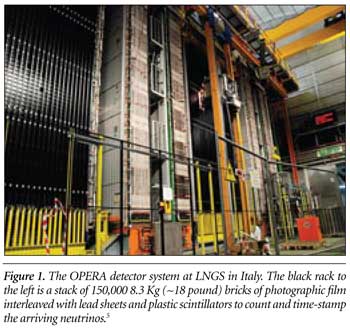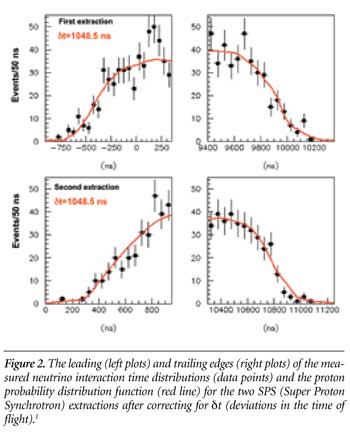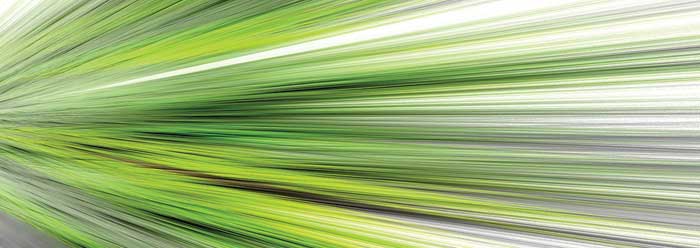Introduction
A consortium of 174 scientists at the CERN and LNGS laboratories announced on September 23, 2011, that they had observed neutrinos traveling 0.0024 percent faster than the currently accepted value for the speed of light.1 If true, this could unravel Albert Einstein’s theory of relativity, or at least cause it to be modified. The famous formula E=mc2 has stood firm for over 100 years and has been incorporated into much of our understanding of space and time.
The implications are enormous. However, such a major finding will require additional scrutiny before it is accepted. And, even if accepted, it may only apply to very specific circumstances. Would such a finding impact recent creationist research?
The Experiment
The OPERA Project (Oscillation Project with Emulsion tRacking Apparatus) is a European experiment whose main goal is to detect neutrino oscillations from the appearance of leptons in a detector located a long distance from a high-energy source of neutrinos. The beam of neutrinos is created by the Super Proton Synchrotron at CERN (European Centre for Nuclear Research) in Switzerland, which directs the beam through the earth toward an underground target at the Gran Sasso Laboratory (LNGS) in Italy 730 km (453.6 miles) away.
The equipment is well-suited to determine the neutrino velocity with high accuracy by measuring the time of flight and the distance between the source of the neutrino beam at CERN and the OPERA detector system at Gran Sasso, which is shown in Figure 1. A very complex method is used to calculate the time of flight for the neutrinos. The authors of the related report note, “It is worth stressing that this measurement [time of flight] does not rely on the difference between a start (to) and a stop signal but on the comparison of two event time distributions.”1 In other words, the time of flight is not measured for a single particle but by a statistical method applied to the distribution of arrival times from multiple neutrinos.
 The baseline was also measured to a high precision. The distance between the focal point of the target and the OPERA reference frame was precisely measured in 2010 following a dedicated geodesy campaign. The distance was determined to be 730,534.61 ± 0.20 meters (453.93316 ± 0.000124 miles). This measurement precision is about 8 inches.
The baseline was also measured to a high precision. The distance between the focal point of the target and the OPERA reference frame was precisely measured in 2010 following a dedicated geodesy campaign. The distance was determined to be 730,534.61 ± 0.20 meters (453.93316 ± 0.000124 miles). This measurement precision is about 8 inches.
Previous experiments for similar baselines but lower neutrino energies and less precision have reported speeds greater than the speed of light by 0.004, 0.0051, and 0.002 percent, respectively.2,3,4 The results from OPERA were based on very high precision, not only for the statistical errors but also for the system (0.00248% ± 0.00028% (stat.) ± 0.0003% (sys.)).
Possible Sources of Error
The most likely source of error in the experiment would seem to be in the method of fitting the time distributions of protons leaving CERN with the time distributions of neutrinos arriving at Gran Sasso. The two distributions are fit to each other, and when they line up give the time of flight, and thus the speed. Figure 2 shows the distributions of the departure and arrival times at CERN and Gran Sasso, respectively.
 The authors slide the red line along the horizontal axis and determine when it best matches the points. This supposedly gives an accuracy of about 10 nanoseconds. This seems too strong a claim, since the horizontal error on the points (the bin width) is five times bigger than this. Also, they seem to assume the red line and the points should match exactly. There seems to be no allowance in their systematic uncertainties for the possibility that the red line might not be a true reflection of the shape of the neutrino “turn on” and “turn off” at Gran Sasso.
The authors slide the red line along the horizontal axis and determine when it best matches the points. This supposedly gives an accuracy of about 10 nanoseconds. This seems too strong a claim, since the horizontal error on the points (the bin width) is five times bigger than this. Also, they seem to assume the red line and the points should match exactly. There seems to be no allowance in their systematic uncertainties for the possibility that the red line might not be a true reflection of the shape of the neutrino “turn on” and “turn off” at Gran Sasso.
For example, at CERN where the red line is measured, all the protons are included in the time profile. By the time the beam gets to Gran Sasso, it has fanned out and is big enough that OPERA only sees neutrinos from part of the beam. So, any correlations between the production time of the neutrinos (where they are on the horizontal axes of those plots) and the angle they are produced at (which determines whether or not they actually get to OPERA) could distort the shape, leading to an uncertainty in the fit and hence an uncertainty in the speed.
Also, note in Figure 2 that the red lines trace a curve that is far from many of the data points. Some are even outside the standard errors shown on the plot. The method by which the statistical error was computed may not adequately account for the variance between the neutrino and proton probability distribution functions.
These concerns are standard fare between theoretical and experimental science. It was Einstein himself, both a theoretician and an experimentalist, who said, “A theory is something nobody believes, except the person who made it. An experiment is something everybody believes, except the person who made it.”6 So, it’s likely that this controversy will continue for some years to come.
Implications on Creationist Views
If the findings of the OPERA group turn out to be true, how would such a finding affect creationist research? For many years, creationists were highly skeptical of relativity and quantum mechanics. But in recent years more and more young-earth creationists have come to believe that relativity is beneficial to young-earth thinking. Humphreys,7 Hartnett,8 and Gentry9 have each used the general theory of relativity to build a case for their cosmogonies. Each has solved various aspects of the mass, space, and time issue in a young universe by solving Einstein’s field equations by using different boundary conditions or suggesting additional coordinates. For example, Humphreys has suggested that rapid expansions of the cosmos at creation and the Flood would have caused time to be accelerated at distances far from earth, permitting light to reach earth from outer space in only thousands of years, not billions.
These theories suggest that the effective speed of light relative to an earth timeframe can change. However, the general theory of relativity they use assumes the speed of light is constant and independent of all moving frames of reference. If it is found that the speed of light is not constant, but can change in the earth’s frame of reference, the equations of relativity may become even more complex than they currently are. Current creationist research is not likely to be nullified by the speed of light not always being constant, but it could complicate attempts to develop alternative cosmogonies.
On the other hand, if the speed of light is found to be changeable under various conditions, this lends credence to the creationist view that basic physical constants are changeable. ICR’s RATE project found evidence that nuclear decay rates have changed in the past.10 Since decay rates, the speed of light, and other constants are tied to each other through physical laws, it’s becoming easier to justify the view that many parts of the cosmos could have been affected by processes that operated in different ways and at different rates in the past.
Of course, Christians who accept the Bible as the Word of God believe that anything is possible with God. When He said He created the world in six days or that He caused a global flood in about a year, we accept this, without fully understanding it, because an omnipotent God revealed it to us. However, as new knowledge is discovered in the physical world around us, we are coming to understand more fully how He may have done it. What a blessing for a believing scientist!
References
- Adams, T. et al. 2011. Measurement of the neutrino velocity with OPERA detector in the CNGS beam. arXiv:1109.4897v1.
- Kalbfleisch, G. R. et al. 1979. Experimental Comparison of Neutrino, Antineutrino, and Muon Velocities. Physical Review Letters. 43 (19): 1361; Alspector, J. et al. 1976. Experimental Comparison of Neutrino and Muon Velocities. Physical Review Letters. 36 (15): 837.
- Adamson, P. et al (MINOS Collaboration). 2007. Measurement of neutrino velocity with the MINOS detectors and NuMI neutrino beam. Physical Review D. 76 (7): 072005.
- Hirata, K. et al. 1987. Observation of a neutrino burst from the supernova SN1987A. Physical Review Letters. 58 (14): 1490; Bionta, R. M. et al. 1987. Observation of a neutrino burst in coincidence with supernova 1987A in the Large Magellanic Cloud. Physical Review Letters. 58 (14): 1494; Longo, M. J. 1987. Tests of relativity from SN1987A. Physical Review D. 36 (10): 3276.
- Electronic detector image obtained from the OPERA website at operaweb.lngs.infn.it.
- Albert Einstein, remark to Herman F. Mark, quoted in Holton, G. 1986. The Advancement of Science, and Its Burdens. New York: Cambridge University, 13.
- Humphreys, D. R. 1994. Starlight and Time. Green Forest, AR: Master Books.
- Hartnett, J. 2007. Starlight, Time, and the New Physics. Powder Springs, GA: Creation Book Publishers.
- See links provided on The Orion Foundation website at www.orionfdn.org.
- Vardiman, L., A. A. Snelling and E. F Chaffin, eds. 2005. Radioisotopes and the Age of the Earth: Results of a Young-Earth Creationist Research Initiative. El Cajon, CA: Institute for Creation Research and Chino Valley, AZ: Creation Research Society.
* Dr. Vardiman is Senior Research Scientist, Astro/Geophysics at the Institute for Creation Research.
Cite this article: Vardiman, L. 2011. Has Einstein’s Limit on the Speed of Light Been Broken? Acts & Facts. 40 (12): 22-23.














